
Fantasy Football Strength of Schedule
A Comprehensible Approach To SOS, Explained Partly Through The Elegant Science of 'Super Punch-Out'
July 6th, 2008 JunkyardJake.Com
If you have tried to read through some of the available dissertations out there explaining various methods of calculating fantasy football strength of schedule, you will probably end up concluding one of two things:
1) While you don't really understand any of it, it does give you flashbacks to 10th grade trigonometry class, and you suddenly feel the urge to either take a nap, or hurl a spitball at someone. -or-
2) You can't help wondering why the Engineering PHds that conceive of these new exciting fantasy football strength of schedule paradigms don't apply some of this intellectual and mathematical horsepower to the development of something really useful, like alternative fuels or those hovercraft things they used to ride around on in the 'Jetson's'.In any event, fantasy football strength of schedule estimations can be valuable when used in moderation. For instance, one specific situation where SOS makes sense, is as an additional factor to help choose between two evenly-rated, usually second-rate players. Stated another way, when making a lineup decision, you never want to leave LaDainian Tomlinson on your bench because you have identified that Rudi Johnson has a more favorable matchup.
Similarly, you will never need strength of schedule charts to choose between Adrian Peterson and LenDale White. However, if you are making that sometimes ambiguous choice between Rudi Johnson and LenDale White, then SOS can be a useful tool.
While the methodology doesn't need to be very complicated, it seems logical that a strength of schedule estimation should conform to a couple basic guidelines:SOS should be based on fantasy points allowed, not the win-loss records of the scheduled opponents.Ok, easy enough, win-loss percentages are useful, but past fantasy points allowed should have a higher correlation with future fantasy points allowed. Stated another way, teams with bad defenses, that allow a bunch of yards, can actually have high winning percentages. Conversely, NFL teams with stifling defenses that allow relatively few yards can have poor winning percentages. (Maybe because the offensive component of the team is ineffective and they end up losing a couple of those exciting 7-6 baseball score games.)Run and pass defenses in any strength of schedule estimation should be considered separately.Once again, pretty simple. A strength of schedule estimation should acknowledge that some team defenses are more competent against the run, while some are decent against the pass and can't stop a running faucet. Still other defenses are completely incompetent at preventing anything, and probably couldn't stop the Olsen twins from connecting on a 70-yard TD bomb 10 seconds before halftime.A great example of how an NFL defense can exhibit a great disparity between run and pass yards allowed, is the 2007 Minnesota Vikings defense.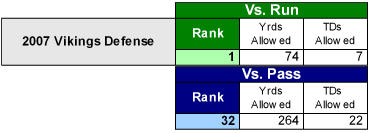 As you can see, although the Vikings ended up as the #1 defense against the run, but were rather generous, and ranked dead-last against the pass. Obviously, it makes sense to consider the Vikings defense in terms of their separate capabilities, because while they have been like a brick wall against fantasy RB's, your fantasy QB might have a pretty decent day against them.
As you can see, although the Vikings ended up as the #1 defense against the run, but were rather generous, and ranked dead-last against the pass. Obviously, it makes sense to consider the Vikings defense in terms of their separate capabilities, because while they have been like a brick wall against fantasy RB's, your fantasy QB might have a pretty decent day against them.
Now, if you are not getting sleepy yet, besides these two guidelines, there are some other ways to improve a strength of schedule calculation to make it even more fantasy football relevant:Strength of schedule should be readjusted each week to reflect the current seasons trends.When you use a strength of schedule tool in a fantasy football magazine, it is probably calculated sometime in May, so it misses some of the information that becomes apparent in the early weeks of the season. For example, factors such as defensive coach changes, scheme changes, free agent additions and defections, productive rookies or the fact that the middle linebacker found a more comfortable pair of cleats than he had last season.
For example:
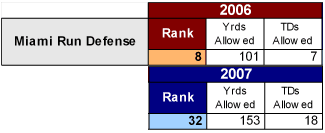 While the Miami defense was a fairly stout # 8 ranked defense against the run in 2006, they regressed badly in 2007. In fact, it is doubtful that anyone expected them to fall all the way from a respectable run defense to the worst in the league. This trend obviously undermined the strength of schedule projections calculated in the preseason of 2007.
While the Miami defense was a fairly stout # 8 ranked defense against the run in 2006, they regressed badly in 2007. In fact, it is doubtful that anyone expected them to fall all the way from a respectable run defense to the worst in the league. This trend obviously undermined the strength of schedule projections calculated in the preseason of 2007.
Here is another egregious defensive team surprise that occurred during 2007: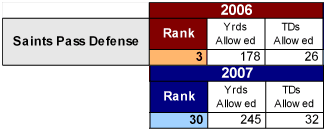 I'm not sure what type of clairvoyant football analyst you need to be to predict that the Saints would go from the #3 ranked pass defense in 2006, to #30th ranked pass defense in 2007, but it's safe to say it was unexpected, and wrecked havoc on many strength of schedule projections.
I'm not sure what type of clairvoyant football analyst you need to be to predict that the Saints would go from the #3 ranked pass defense in 2006, to #30th ranked pass defense in 2007, but it's safe to say it was unexpected, and wrecked havoc on many strength of schedule projections.
So, to make a long story mercifully shorter, using the current season trends, as they become available, can improve the relevancy of a strength of schedule tool. It makes sense to capture the new trends as they emerge and use them in combination with last seasons information.Fantasy playoff week strength of schedule should be calculated separatelyOf course the coolest thing about fantasy football, is actually seeing your plan come together, and somehow winning your league championship, especially if the spoils include getting to do a victory dance on the hood of your buddy's Toyota Camry, as per your mutual preseason agreement. However, any experienced fantasy player knows that, regardless of how dominating your team might be during the early weeks of the season, an untimely meltdown by your squad during the critical fantasy playoff weeks will abruptly end any championship hopes.
Ideally, to make a strength of schedule tool more useful, it should provide specific calculations for the important fantasy playoff weeks. These numbers can provide additional information to help decide between closely valued players at draft time, and of course help to make lineup decisions in those final weeks. Defensive teams should be evaluated based the potency of the offensive teams that they faceThis final point is a little confusing, but basically can be explained, like any advanced mathematical approach, through examples citing the universally recognized, vintage Nintendo video game, 'Super Punch-Out'.
If you recall, 'Super Punch-Out' was a highly realistic sports simulation where you, as the protagonist boxer, would test your boxing skills against increasingly skilled opponents. For example, 'Gabby Jay' the 56 year-old Frenchmen did not typically offer much resistance and could be beaten easily, while 'Super Macho Man' was rather difficult to beat (and also quite a smug jerk about it).
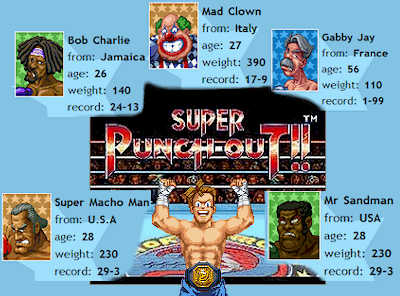
So what in the world does this have to do with fantasy football strength of schedule calculation? Well, in estimating a defensive team's ability to stop an offense in the future, it makes sense to consider the level of offensive firepower that the team has faced in the past, and how they fared.
Let's take the 2007 Green Bay Packers defense, which was ranked #11 and only allowed 314 yards per game. That's very impressive, but note that the Packers played against some fairly anemic offenses last season. In the diagram below, the Chicago Bears offense is represented by the 56 year-old Frenchmen, and the KC Chiefs offense is equated to a scrawny Jamaican with a weak jab. (Both of these analogies are believed to be scientifically accurate.)
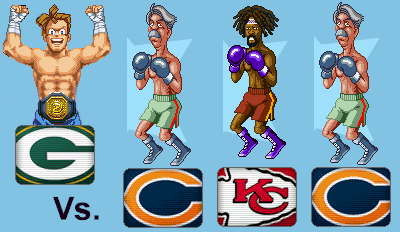
Now let's consider the San Diego Chargers defense, which ranked #14 in the league for 2007, and allowed 320 yards per game:
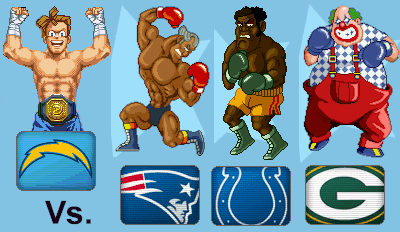
As noted above, the Chargers played against some very potent offensive teams in 2007, the New England Patriots (Super Macho Man), the Indianapolis Colts (Mr. Sandman) and the Green Bay Packers, represented by a 390 lb boxing clown.
So, the point is this - when comparing the Packers and Chargers as defensive opponents in a 2008 strength of schedule calculation, the Chargers should be rated as the tougher defense to play against. This is despite the fact that the Chargers ended up allowing slightly more yards than the Packers in 2007. San Diego's performance needs to be adjusted to account for the fact that they played against higher caliber offensive units.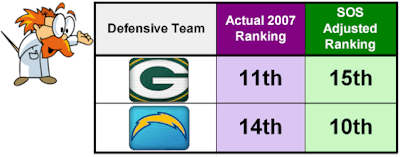
So does any of this mess actually work, where can I find SOS estimates for 2008, and how do I lose that stubborn last 20 pounds?Good questions! (although we can't help you with the 20 pounds thing).
Here are some examples from week 14 of the 2007 season, where strength of schedule differences could have helped you make a better lineup decision:
Lineup decision - Ryan Grant vs. Oakland -or- Frank Gore vs. Minnesota
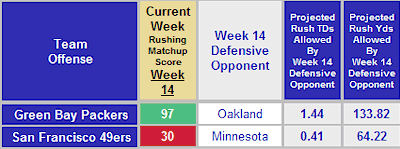
Based on the week 14 ratings in the table above, Ryan Grant had a '97' rated matchup and Frank Gore had a '30' rating. Higher ratings in this case mean easier matchups, and the disparity in 'matchup scores' is clearly consistent with the fact that Ryan Grant had a chance to do well against the ridiculously bad 2007 Oakland run defense. Conversely, Frank Gore was probably in for a challenging day versus the Vikings very aggressive run defense.
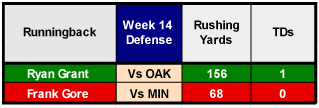 Sure enough, in this situation where we were choosing between relatively equal players, and using matchups as an additional deciding factor, it worked out very well. Ryan Grant had a great day against the hapless Oakland run defense, with 156 yards and 1 TD. Also as expected, Frank Gore had a rough outing versus the Vikings, with only 68 yards and zero TDs.
Sure enough, in this situation where we were choosing between relatively equal players, and using matchups as an additional deciding factor, it worked out very well. Ryan Grant had a great day against the hapless Oakland run defense, with 156 yards and 1 TD. Also as expected, Frank Gore had a rough outing versus the Vikings, with only 68 yards and zero TDs.
Lineup decision - Chris Redman vs. New Orleans -or- Kyle Boller vs. Indianapolis
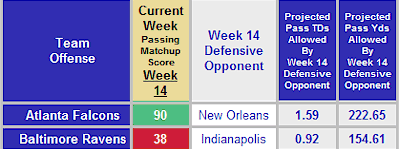
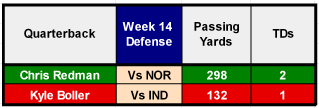 Once again, in a situation where we need to pick between two similar players, in this case two similarly bad options like Atlanta's Chris Redman vs. Baltimore's Kyle Boller, strength of schedule proves to be a useful piece of information. Note that Chris Redman had a pretty good day against the weak New Orleans Saints pass defense, while Kyle Boller had a predictably unimpressive game facing the Indianapolis Colts secondary.
Once again, in a situation where we need to pick between two similar players, in this case two similarly bad options like Atlanta's Chris Redman vs. Baltimore's Kyle Boller, strength of schedule proves to be a useful piece of information. Note that Chris Redman had a pretty good day against the weak New Orleans Saints pass defense, while Kyle Boller had a predictably unimpressive game facing the Indianapolis Colts secondary.
So anyway, thanks for making it through another treatise on the subject of fantasy football strength of schedule, hopefully it wasn't too painful. If you would like to see the actual numbers for the 2008 season, you can find our complete strength of schedule estimations here:
2008 Rushing Offense Strength of Schedule
2008 Passing Offense Strength of Schedule


























 Sure enough, in this situation where we were choosing between relatively equal players, and using matchups as an additional deciding factor, it worked out very well. Ryan Grant had a great day against the hapless Oakland run defense, with 156 yards and 1 TD. Also as expected, Frank Gore had a rough outing versus the Vikings, with only 68 yards and zero TDs.
Sure enough, in this situation where we were choosing between relatively equal players, and using matchups as an additional deciding factor, it worked out very well. Ryan Grant had a great day against the hapless Oakland run defense, with 156 yards and 1 TD. Also as expected, Frank Gore had a rough outing versus the Vikings, with only 68 yards and zero TDs.
 Once again, in a situation where we need to pick between two similar players, in this case two similarly bad options like Atlanta's Chris Redman vs. Baltimore's Kyle Boller, strength of schedule proves to be a useful piece of information. Note that Chris Redman had a pretty good day against the weak New Orleans Saints pass defense, while Kyle Boller had a predictably unimpressive game facing the Indianapolis Colts secondary.
Once again, in a situation where we need to pick between two similar players, in this case two similarly bad options like Atlanta's Chris Redman vs. Baltimore's Kyle Boller, strength of schedule proves to be a useful piece of information. Note that Chris Redman had a pretty good day against the weak New Orleans Saints pass defense, while Kyle Boller had a predictably unimpressive game facing the Indianapolis Colts secondary.